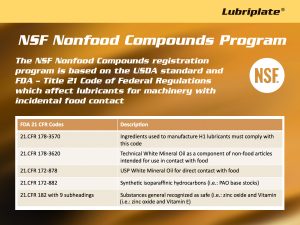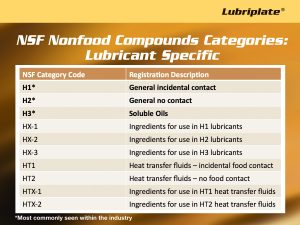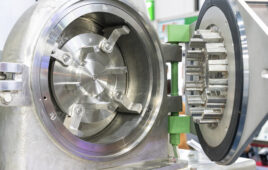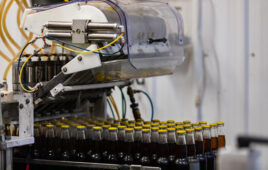Jim Girard, VP/CMO, LUBRIPLATE Lubricants Co.
Technological advances in H-1/food grade lubricants mean that food, beverage and pharmaceutical processors should not hesitate to convert to a 100% H-1/food grade lubrication program. Converting to such a program helps consolidate lubricant choices, reduces lubricant misapplication, and helps to ensure a safe product for the consumer.
Food grade lubricants were first introduced and used in the United States market since the early 1960s. Since their initial development, there have been technological advances with research, development, introduction and use of food grade lubricants.
Title 21 of the FDA’s Code of Federal Regulations (CFO) presents many sections on authorized ingredients that may be used to produce food grade lubricants.
The Food Safety and Inspection Service (FSIS) of the United States Department of Agriculture (USDA) monitors and authorizes lubricants that could be used on machinery that may have incidental contact with food. This is known as the USDA/FSIS “Prior Approval Program for Non-food Compounds and Proprietary Substances.”
The lubricants’ industry authorization and monitoring program changed drastically in 1998 when the USDA/FSIS eliminated its “Prior Approval Program” and “White Book” authorization program for non-food compounds. The question was, should the lubricants industry engage in self-monitoring for H-1/food grade lubricants, or would a third-party professional monitoring organization step forward and adopt a food grade lubricants’ monitoring program?
The National Sanitation Foundation (NSF,) based in Ann Arbor, Michigan, stepped forward and produced an industry authorization and monitoring program, which closely mirrored the former USDA/FSIS program. The worldwide lubricants industry quickly committed to the NSF’s program, and today, the NSF is the leader in authorizing and monitoring H-1/food grade lubricants for all lubricants manufacturers. NSF H-1 authorized food grade lubricants are posted on the NSF’s website.

This chart displays the sections in the FDA’s Title 21 and presents brief descriptions of some of the more popular ingredients used by lubricant manufacturers to produce their food grade lubricants.
The International Standard Organization (ISO) also developed the ISO-21469 certification and registration process for lubricants used in specialized industries such as food, pharmaceuticals, cosmetics, animal feed manufacturing. This is a very stringent standard and registration process in which lubricants manufacturers must first be registered and maintain the ISO-9001 Quality Management standard, which demonstrates the commitment to an overall Quality Management System.
Finally, H-1/food grade lubricants also are part of Hazard Analysis Critical Control Point Programs (HACCP). In the United States, the FDA and the USDA demand that food and beverage processors develop HACCP programs in which lubricants may be considered as potential chemical hazards. However, if food and beverage processors switch to 100% H-1/food grade lubrication programs, then lubricants are not considered potential chemical hazards and an HAACP plan is not necessary for a 100% H-1/food grade lubrication program.

The National Sanitation Foundation (NSF,) produced an industry authorization and monitoring program, which closely mirrored the former USDA/FSIS program. The NSF is the leader in authorizing and monitoring H-1/food grade lubricants for all lubricants manufacturers.
Lubrication suppliers should be aware of all industry standards that affect H-1/food grade lubricants. Food grade lubricants packaging and literature should clearly define the product and relate to all of these industry standards. Consumers must watch for unscrupulous and confusing claims on packaging and in product literature.
H-1/food grade lubricants have not been immune to high technology. In the 1960s there were not many fluid base stocks, additives or grease thickeners available listed in the FDA’s Title 21 CFR sections. This resulted in poor performance of H-1/food grade lubricants.
However, technological has changed the availability of H-1/food grade lubricants. In 2014, H-1/food grade lubricants can accommodate every application on machinery in food, beverage and pharmaceutical processing facilities from refrigeration compressors, to freezer conveyor chains, to gear boxes to filling, seaming and closing equipment.
For example, in the early 1960s, it was impossible to find an H-1/food grade grease that delivered both anti-wear and extreme pressure protection. Today, calcium sulphonate thickened greases made with USP white mineral oils and synthetic polyalphaolefin (PAO) base stocks are truly anti-wear and extreme pressure lubricants.
Lubricant manufacturers have been able to add anti-microbial additive to their products. Anti-microbial additives help prevent the decomposition of lubricants caused by microorganisms. Many anti-microbial additives are registered with the EPA.
The use of synthetic polyalkylene glycol (PAG) base stocks to manufacture H-1/food grade gear oils has produced H-1/food grade gears oils, which deliver extended drain intervals and long anti-wear and extreme pressure protection. Gear reducer original equipment manufacturers (OEMs) now have no fear in recommended H-1/food grade synthetic PAG-based gear oils.
Synthetic polyol ester (POE) food grade fluid technology delivers optimum lubrication protection for high heat oven chains in bakeries. POEs have unmatched oxidation stability that nearly eliminates carbon deposits and keeps the chains clean.
Silicones and PTFE are also used effectively as H-1/food grade lubricants.
Synthetic H-1/food grade technology also helps to consolidate the amount of lubricants required. For example, synthetic PAOs work effectively in both air compressors and hydraulic systems. It is possible to use the same ISO-46 fluid for both air compressors and hydraulic systems.
All of these technological advances in H-1/food grade lubricants mean that food, beverage and pharmaceutical processors should not hesitate to convert to a 100% H-1/food grade lubrication program. Converting to 100% H-1/food grade program delivers money-saving lubricants consolidation, a reduction in lubricants misapplication, sustainability and helps to ensure a safe product for the ultimate consumer.
Filed Under: Food + beverage





Tell Us What You Think!